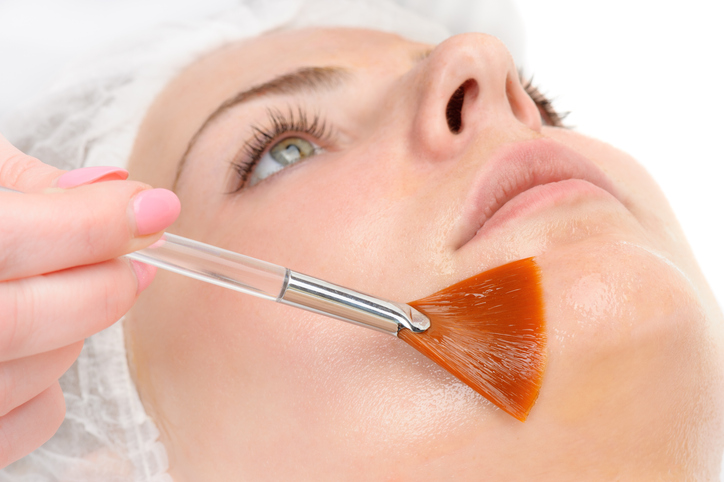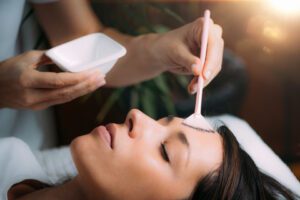Introduction to chemical peels and their role in the cosmetic industry
Chemical peels are a standard cosmetic procedure that can improve the appearance of the skin. Applying a chemical solution to the skin removes the top layers of dead skin cells, revealing a smoother, healthier-looking complexion. This treatment can address various skin concerns, such as fine lines and wrinkles, irregular skin tone and texture, and acne. It is typically performed by a trained skincare professional and can provide significant results with little downtime.
Unlike other skin treatments, such as microdermabrasion or facials, chemical peels penetrate deeper into the skin to produce more dramatic results. They are often used to minister various skin concerns, including fine lines and wrinkles, uneven skin tone and texture, and acne. In the hands of a trained skincare professional, chemical peels can significantly improve the skin with little downtime.
The various types of chemical peels available and their specific benefits
There are three primary types of chemical peels: light or superficial peels, medium peels, and deep peels. Each type of peel uses a different strength of the chemical solution and is designed to treat various skin concerns.
Light or superficial peels, also known as lunchtime peels, are the gentlest sort of chemical peel. They use a weaker acid solution, such as glycolic or salicylic acid, to gently exfoliate the top layer of skin. These peels are typically used to improve the appearance of mild acne, uneven skin tone and texture, and fine lines. They require little downtime and can be performed in as little as 30 minutes.
Medium peels, also known as moderate peels, use a more robust acid solution, such as trichloroacetic acid (TCA), to penetrate deeper into the skin. These peels effectively improve the appearance of moderate wrinkles, sun damage, and uneven skin tone. They typically require a few days of downtime, during which the skin will be red and may peel or flake.
Deep peels, also known as phenol peels, are the most vital type of chemical peel. They use a solution of phenol, a powerful acid, to penetrate deeply into the skin to produce the most dramatic results. These peels often treat deep wrinkles, extensive sun damage, and precancerous skin growth. They require a longer recovery time and may cause scarring if not performed correctly.
Overall, the type of chemical peel that is right for you will depend on your skin concerns and desired results. A skincare professional can help you choose the appropriate peel and customise it to your needs.
Uncover the Transformative Power of Chemical Peels for a Radiant, Youthful-Looking Complexion
Chemical peels are a popular cosmetic treatment that can improve the skin’s appearance in several ways. By extracting the top layer of dead skin cells, chemical peels can uncover smoother, healthier-looking skin underneath. They can also stimulate the production of collagen and elastin, the proteins that give the skin its elasticity and structure, helping to reduce the appearance of fine lines and wrinkles and giving the skin a more youthful, radiant appearance.
In addition to improving the texture and tone of the skin, chemical peels can also treat specific skin concerns. Removing the build-up of dead skin cells and oil in the pores can help unclog the pores and prevent future breakouts. In addition, they can improve the appearance of uneven skin tone and hyperpigmentation, resulting in a more even and radiant complexion. Chemical peels can provide significant improvements to the skin with little downtime.
Chemical peels effectively improve the skin’s appearance and address specific skin concerns. They can provide significant results with little downtime, making them a popular choice in the cosmetic industry.
The process of undergoing a chemical peel
The process of undergoing a chemical peel typically involves the following steps:
- Consultation with a skincare professional: Before undergoing a chemical peel, it is essential to consult a trained skincare professional. They will evaluate your skin, discuss your goals and concerns, and recommend the appropriate type of peel for your individual needs.
- Pre-treatment instructions: Before your peel, your skincare professional will provide pre-treatment instructions. These may include avoiding certain skincare products, such as retinol or exfoliants, in the days leading up to your peel. They may also recommend using a skin-lightening agent, such as hydroquinone, to improve the peel results.
- The chemical peel treatment: During the chemical peel treatment, the skin care professional will cleanse your skin and apply the chemical solution to your face. The solution will be left on the skin for a specific time, depending on the peel being performed. After the appropriate time has elapsed, the solution will be neutralised, and the peel will be removed.
- Post-treatment care and recovery: Your skincare professional will provide post-treatment instructions after the chemical peel treatment. These may include applying moisturiser and sunscreen, avoiding direct sun exposure, and avoiding certain skincare products. The treated skin may be red, irritated, swollen, peeling or flaking in the days following the peel. The recovery time will vary depending on the type of peel performed.
The process of undergoing a chemical peel is relatively quick and straightforward. With the guidance of a trained skincare professional, you can safely and effectively improve the appearance of your skin.
The potential risks and side effects of chemical peels
While chemical peels are generally safe and effective, there are potential risks and side effects. A chemical peel’s most common side effect is mild redness and irritation, which typically subsides within a few days. More severe side effects, such as scarring and changes in skin colour, are possible but less common.
Scarring is a potential risk of all chemical peels, but it is more likely to occur with deep peels. If a deep peel is not performed correctly, the skin may scar as it heals. To reduce the risk of scarring, it is crucial to choose a trained and experienced skincare professional to perform your peel.
Changes in skin colour are another potential side effect of chemical peels. The treated skin may become darker or lighter than the surrounding skin, depending on the peel used and the individual’s skin type. This is more likely to occur with medium and deep peels, but it can also happen with light peels. To minimise the risk of changes in skin colour, it is essential to dodge sun exposure before and after the peel and to use a broad-spectrum sunscreen with a high SPF.
While chemical peels are generally safe and effective, it is vital to know the potential risks and side effects. By choosing a trained and experienced skincare professional and following the pre-and post-treatment instructions, you can minimise the risks and maximise the benefits of your chemical peel.
Conclusion and summary of the benefits of chemical peels in the cosmetic industry
In conclusion, chemical peels are a safe and effective way to improve the appearance of the skin. They can provide significant results, such as reducing fine lines and wrinkles, improving skin tone and texture, and treating acne. Various chemical peels are available, each with specific benefits and potential risks. The appropriate peel for you will depend on your skin concerns and desired results.
Under the guidance of a trained skincare professional, the process of undergoing a chemical peel is relatively quick and straightforward. With the right pre- and post-treatment care, you can safely and effectively achieve smoother, healthier-looking skin.
Overall, chemical peels are an essential and valuable tool in the cosmetic industry, offering numerous benefits to those seeking to improve their skin’s appearance.







